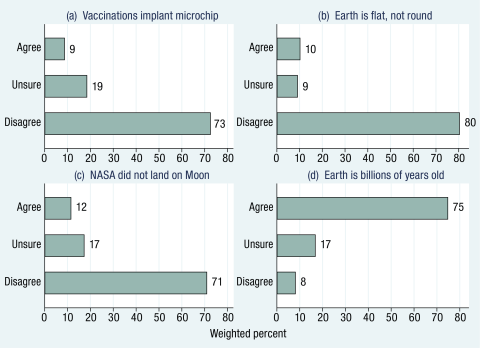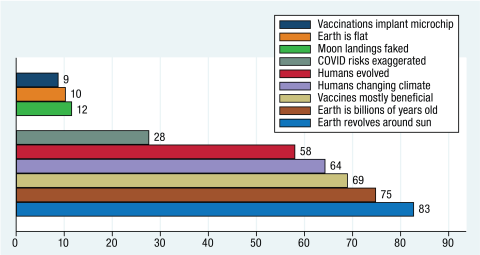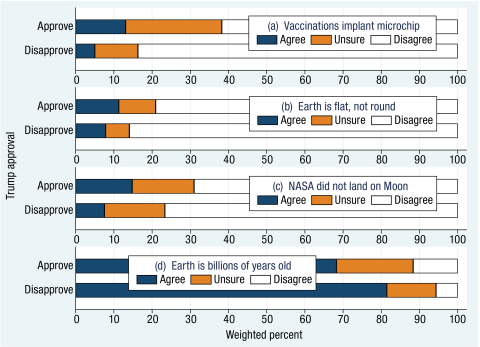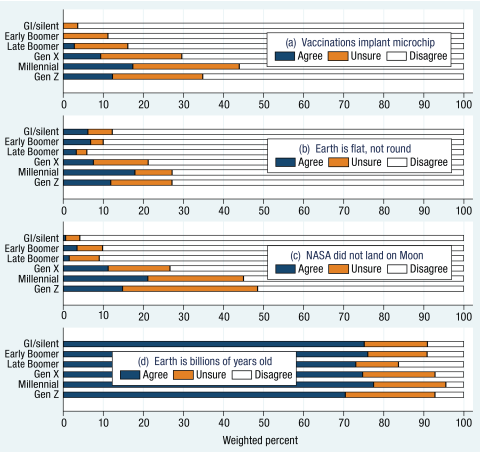Key Findings

On a nationwide U.S. survey, around 10 percent of respondents agreed with conspiracy claims that the Earth is flat, NASA faked the Moon landings, or COVID-19 vaccinations implant tracking microchips.


Pseudo-scientific conspiracy claims get wide exposure on social media such as YouTube, Facebook, and Twitter, where they are avidly shared by believers and trolls, giving an impression to some people that support for such claims is growing. But among the general public, just how prevalent are such beliefs? On a nationally representative survey, we asked whether people agreed, disagreed, or were unsure about the following conspiracy claims. Is the Earth really flat? Did NASA fake the Moon landings? Do COVID-19 vaccinations implant people with microchips for tracking? And for comparison, we asked similar questions about some basic scientific facts, such as whether Earth is billions of years old.
Acceptance or openness to conspiracy beliefs was significantly higher among certain subgroups, including Millennials and supporters of ex-president Trump. Conspiratorial thinking or conspiracist ideation has become a prominent feature of current U.S. politics, shaping how many people think about elections, the COVID-19 pandemic, and other issues. Origins and explanations for conspiratorial beliefs are consequently the focus of much research.1 The survey results described below fit generally with previous studies, while adding new details.
The conspiracy and science questions described here formed part of an online survey called POLES 2021, answered by 1,134 U.S. adults in summer and fall 2021.2 By design, the survey sample was nationally representative with respect to age, gender, race, education, and political party. Sampling weights allowed final small adjustments toward a representative profile. As recommended with most online surveys, the design included attention checks to screen out thoughtless respondents—such as those who answered too quickly, or “straightlined” their agreement or disagreement with incompatible statements.
The set of questions analyzed here asked whether respondents agreed, disagreed, or were unsure about a series of statements that mixed pseudo-science conspiracy claims with well-established scientific facts. The most widespread conspiracy claims in the United States today, such as belief in a “stolen” 2020 election, align with political identity. For purposes of this survey, however, we focused on science-related statements without overt political content:
NASA astronauts did not really land on the Moon.
The Earth is billions of years old.
The Earth is flat, not round.
Humans evolved from earlier forms of life, over millions of years.
COVID dangers have been exaggerated by scientists
Climate change is happening now, caused mainly by human activities.
Vaccines have mostly been a benefit to human health.
Vaccinations for COVID-19 implant microchips to track people.
The Earth revolves around the Sun.
For each of these statements there exists a scientific consensus, either for or against. The statements about Moon landings, flat Earth, and vaccine microchips have no basis in science; people who say they agree with these statements are embracing conspiracy beliefs instead, and even those who are unsure indicate that they are at least open to such unfounded beliefs. For other statements, however, survey responses contrary to the scientific consensus do not necessarily reflect science rejection. For example, most scientists might disagree with a general statement that COVID dangers have been exaggerated by scientists, but some could think of instances where this occurred, and the informed public would be aware of conflicting opinions. So respondent agreement with the COVID-exaggerated statement might reflect conspiracy views, but might also reflect awareness of real controversies, by respondents with generally pro-science views. Scientific consensus on the other statements above is clear-cut, and well-studied in some cases, such as climate change.3 For some questions, however, “unsure” responses to scientific statements should not necessarily be read as openness to conspiracy alternatives; people reasonably might not know. Is the Earth billions of years old, for instance, or is the correct number millions or trillions?4
Figure 1 charts the responses to four of these questions—three false conspiracy claims (vaccination microchips, flat Earth, Moon landings faked), and one scientific fact (the Earth is very old). Agreement with the conspiracy claims is not high, ranging from 9 to 12 percent, and disagreement from 71 to 80 percent. Nine to 19 percent said they were unsure about these claims. In contrast, three-fourths of the sample agreed with scientists that Earth is billions of years old, and some of the 17 percent “unsure” might agree Earth is quite old, but be uncertain about the numbers.
Figure 2 charts the agreement percentages for nine conspiracy or scientific statements, ordered from the lowest to highest. As noted above, about 9 percent think that COVID-19 vaccinations implant microchips to track people, and 10 percent think the Earth is flat. Twenty-eight percent agreed that the dangers of COVID-19 have been exaggerated by scientists. At least some scientists might agree with this statement as well, thinking of overstatements by certain colleagues. The overall consensus, however, is that COVID-19 dangers are quite substantial and have often been understated. Despite such mistrust, agreement with other scientific facts is substantially higher, ranging from 58 percent for human evolution to 83 percent for Earth revolving around the Sun. That around 10 percent agree with wild conspiracy claims, whereas 58 to 83 percent agree with basic scientific facts, might be seen as either good news or bad news from a science-literacy perspective.

Source: POLES 2021 survey

Source: POLES 2021 survey
Notable differences by political identity have been shown for a wide range of topics including science and conspiracy beliefs.5 Political identity has historically been defined in terms of party, or liberal vs. conservative ideology, but some recent studies have found that support for Donald Trump marks divisions that can be even sharper.6 Figure 3 tests for such divisions by comparing people according to how they answered this question:
Would you say that you approve or disapprove of the way Donald Trump handled his job when he was president?
Answers ranged from “strongly approve” to “strongly disapprove” on a 7-point scale. About 60 percent chose one of those two extremes, while only 8 percent gave neutral answers (excluded from Figure 3). Overall, the “approve” and “disapprove” fractions in this survey were balanced at 46 percent each. Figure 3 compares responses of Trump approvers and disapprovers on four conspiracy or science statements.
Trump approvers are more likely than Trump disapprovers to agree with conspiracy claims that vaccinations implant tracking microchips (3a), the Earth is flat (3b), or NASA astronauts did not land on the Moon (3c); but they are less likely to agree with scientists that the Earth is billions of years old (3d). Trump approvers also include higher fractions saying they are unsure about each statement. Overall, Trump approvers are more than twice as likely as disapprovers to agree or be uncertain that vaccinations implant tracking microchips (38 vs. 16 percent); half again as likely to agree or be uncertain that the Earth is flat (21 vs. 14 percent); and also more likely to agree or be uncertain that NASA astronauts did not land on the Moon (31 vs. 23 percent). On the other hand, Trump approvers are considerably less likely than disapprovers to agree with scientists that the Earth is billions of years old (68 vs. 81 percent).
Several other political patterns, not shown in Figure 3, also go against the scientific consensus. Trump approvers are more likely to agree that COVID dangers have been exaggerated by scientists (46 percent among Trump approvers, vs. 11 percent among disapprovers), but less likely to agree that humans evolved from earlier forms of life over millions of years (50 vs. 68 percent), human activities are changing the climate (50 vs. 79 percent), or vaccines are mostly beneficial (61 vs. 79 percent). Only one question, whether the Earth revolves around the Sun, evoked no significant partisan gap (82 vs. 85 percent).
Generational Patterns
Apart from politics, age or generational patterns also are prominent in many surveys—including, as will be noted, surveys on conspiracy beliefs. One common way to define living U.S. generations by birth years is given in Box 1. Figure 4 applies these definitions to draw generational comparisons of conspiracy and science statement responses.

Note: Differences between Trump approvers and disapprovers are statistically significant (p < 0.05 to p < 0.001, tested by ordered logit regression). Source: POLES 2021 survey.

Note: Generational differences regarding vaccination microchips, flat Earth, and Moon landings are statistically significant (all p < 0.001); generational differences regarding age of the Earth are not significant (p = 0.77; all tests by ordered logit regression). Source: POLES 2021 survey.
Generational differences regarding the age of the Earth (Figure 4d) exhibit no clear pattern. The three conspiracy statements, on the other hand, all show similar and statistically significant patterns: agreement with or uncertainty about these conspiracy beliefs is higher among younger generations. Millennials are most likely to agree with all three conspiracies: that vaccinations implant microchips (17 percent), the Earth is flat (18 percent), and NASA astronauts did not land on the Moon (24 percent). The GI, Silent, and Boomer generations are much more skeptical about these claims (0 to 7 percent agree).
Apart from Trumpism (Figure 3) and generation (Figure 4), one other characteristic related to many of these views is, not surprisingly, respondent education. People with higher education are significantly more likely to disagree that Earth is flat or scientists exaggerated the dangers of COVID, and more likely to agree with the scientific consensus regarding human evolution, climate change, vaccine benefits, and whether the Earth goes around the Sun. Education makes no significant difference, however, in responses to the vaccine microchip, Moon landing, or age of the Earth statements.
- GI and silent generations, born before 1946
- Early boomers, born 1946–1955
- Late boomers, born 1956–1964
- Generation X, born 1965–1980
- Millennials, born 1981–1996
- Generation Z, born 1997–present (2021 for this survey)
These conspiracy topics have been explored in several previous surveys. Differences in question wording, sample selection, and survey year prevent direct comparisons, but they nevertheless provide some reality checks. In broad terms, results from previous surveys are consistent the conclusions drawn above.
Regarding Moon landings, a 2019 survey by SatelliteInternet.com (n = 500, but representativeness unknown) found that 10 percent of their respondents believed the Moon landings were faked.7 This resembles the 12 percent observed in our POLES 2021 survey, well within its margins of error. Together, both surveys hint at upward movement since a Gallup poll asked a similar question in 1999. In that 1999 Gallup survey (n = 1,061), only 6 percent thought the Moon landings were faked.8 Older generations, including most adults for the 1999 survey, had watched Moon launches and landings themselves, in a time of national pride. For younger generations these events are historical reports, leaving more room for conspiracy beliefs and the wide generation gap in Figure 4c above.
That historical explanation cannot be the only reason for generational differences, however, because similar differences occur with other conspiracies too. A February 2018 YouGov survey (n = 8,215) found that 18 to 24 year olds were less sure than other age groups that the Earth is round. The 2018 survey’s question was poorly worded, leading to misinterpretations and headlines declaring that “one-third of Millennials believe Earth is flat.”9 Greater openness to flat-Earth conspiracies among this age group nevertheless is clear in the 2018 YouGov survey, as it is with our 2021 data in Figure 4b.
A newer Economist/YouGov survey (n = 1,500), conducted in 2021, asked a number of conspiracy questions that can be roughly compared with our survey in the same year.10 This Economist/YouGov survey found that 12 percent agree the Moon landings were staged (matching the 12 percent in Figure 1a), and that 20 percent thought it was true or probably true that the government was using COVID-19 vaccinations to microchip the population (compare with 9 percent agree, and 19 percent unsure, in Figure 1c). In the Economist/YouGov survey, vaccines/microchip conspiracy responses also show generational differences (highest among 30–44 year olds) and a wide political gap (almost four times higher among Trump supporters), consistent with the patterns observed in Figures 3a and 4a.
Greater Millennial or Gen Z openness to Moon landing conspiracies could partly reflect their post-Space Race generational histories. History does less well at explaining why Millennial and Gen Z respondents should be more open to flat earth and microchip conspiracies. One alternative explanation is that younger generations include more people who frequent conspiracy-rich corners of the Internet. Broad anti-vaccine claims abound on social media, recirculating reports that have been discredited in the scientific literature.11 Millennial and Gen Z respondents also were least likely to agree that vaccines have mostly been a benefit to human health (60 or 56 percent, compared with 68 to 89 percent among older generations). Regarding the technically nonsensical microchip claim, it could also be relevant that younger generations have become accustomed to constant public and private surveillance by other technical means. Generational perceptions of science do not all go in one direction, however. Younger respondents were significantly more likely to agree with the scientific consensus that climate change is happening now, caused mainly by human activities—71 or 79 percent among Millennials and Gen Z, compared with 47 percent among the oldest group, Silent/GI generations; and 56 to 60 percent among Boomers and Gen X.
Many analyses of conspiracy beliefs, dating back at least to Richard Hofstadter’s 1964 article on “The paranoid style in American politics,” have noted a strong, although not exclusive, correlation between conspiratorial thinking and conservative ideology.12 Specific conspiracies promoted by conservative leaders have changed through the years, from claims of ubiquitous subversion by Soviet agents in the 1950s, to claims of conspiracies against Russia in recent years, along with politician-directed accusations (Obama is a Muslim; the 2020 election was “stolen” from Trump) and others that are directed against scientists (climate change, vaccinations, and pandemic precautions are hoaxes). Not only particular conspiracy beliefs, but also conspiratorial worldviews in general, are found to be more prevalent among conservatives.13 The political patterns in flat-Earth and Moon-landing responses seen in Figure 3 are new, hence in need of replication, but they fit with the broad conclusions of previous studies.
1. For examples, see:
- Del Vicario, M., A. Bessi, F. Zollo, F. Petroni, A. Scala, G. Caldarelli, H.E. Stanley, and W. Quattrociocchi. 2015. “The spreading of misinformation online.” Proceedings of the National Academy of Sciences. https://doi.org/10.1073/pnas.1517441113
- Jamieson, K.H. and D. Albarracin. 2020. “The relation between media consumption and misinformation at the outset of the SARS-CoV-2 pandemic in the U.S.” Harvard Kennedy School Misinformation Review, Special Issue on Covid and Misinformation. https://doi.org/10.37016/mr-2020-012
- Lewandowsky, S., G.E. Gignac, and K. Oberauer. 2013. “The role of conspiracist ideation and worldviews in predicting rejection of science.” PLOS One 8(10): e75637. https://doi.org/10.1371/journal.pone.0075637
- Goldberg, Z.J., and S. Richey. 2020. “Anti-vaccination beliefs and unrelated conspiracy theories.” World Affairs. https://doi.org/10.1177/0043820020920554
2. Sampling for the 2021 Polar Environment and Science (POLES 2021) survey was organized by Qualtrics, with questions designed by Carsey School researchers at the University of New Hampshire. Research protocols were approved by the Institutional Review Board for the Protection of Human Subjects at the University of New Hampshire. The survey’s overall goals were to assess U.S. public perceptions and knowledge about science, following up on a 2016 survey with similar aims (POLES 2016). For some results from that earlier survey, see:
- Hamilton, L.C. 2016. “Where is the North Pole? An election-year survey on global change.” Durham, NH: Carsey School of Public Policy. https://dx.doi.org/10.34051/p/2020.274
- Hamilton, L.C. 2018. “Self-assessed understanding of climate change.” Climatic Change 151(2):349–362. https://doi.org/10.1007/s10584-018-2305-0
- Brown, A. and L.C. Hamilton. 2021. “Interaction effects on support for climate-change mitigation.” Social Science Quarterly 102: 2649–2660. https://doi.org/10.1111/ssqu.13087
3. J. Cook, N. Oreskes, P.T. Doran, W.R.L. Anderegg, B. Verheggen, E.W. Maibach, J.S. Carlton, S. Lewandowsky, A.G. Skuce, S.A. Green, D. Nuccitelli, P. Jacobs, M. Richardson, B. Winkler, R. Painting, and K. Rice, “Consensus on Consensus: A Synthesis of Consensus Estimates on Human-Caused Global Warming,” Environmental Research Letters 11, no. 4 (2016). https://iopscience.iop.org/article/10.1088/1748-9326/11/4/048002
4. Geologists reckon the Earth’s age to be over 4.6 billion years. For an explanation of evidence for this particular age, see: U.S. National Park Service. 2018. “Age of the Earth.” https://www.nps.gov/subjects/geology/age-of-the-earth.htm
5. For examples, see:
- Jamieson and Albarracin, note 1.
- Lewandowsky et al., note 1.
6. For examples, see:
- Brown and Hamilton, note 2.
- Hamilton, L.C. 2017. “On renewable energy and climate, Trump voters stand apart.” Durham, NH: Carsey School of Public Policy. http://scholars.unh.edu/carsey/293
- Safford, T.G., E. Whitmore, and L.C. Hamilton. 2021. “Scientists, presidents, and pandemics—Comparing the science-politics nexus during the Zika virus and COVID-19 outbreaks.” Social Science Quarterly. http://doi.org/10.1111/ssqu.13084
- Shao, W. and F. Hao. 2019. “Approval of political leaders can slant evaluation of political issues: Evidence from public concern for climate change in the USA.” Climatic Change 158(2): 201–212. https://doi.org/10.1007/s10584-019-02594-4
7. Armstrong, R.L. 2019. “New survey suggests 10% of Americans believe Moon landing was fake.” Satellite Intel.com (July 10, 2019). https://www.satelliteinternet.com/resources/moon-landing-real-survey/
8. Newport, F. 1999. “Landing a man on the Moon: The public’s view.” Gallup News Service (July 20, 1999). https://news.gallup.com/poll/3712/Landing-Man-Moon-Publics-View.aspx
9. Dean, S. 2018. “No, one-third of Millennials don’t actually think Earth is flat.” Science Alert (April 4, 2018). https://www.sciencealert.com/one-third-millennials-believe-flat-earth-conspiracy-statistics-yougov-debunk
10. The Economist/YouGov Poll. 2021. “July 10–13—1500 U.S. Adult Citizens.” https://docs.cdn.yougov.com/w2zmwpzsq0/econTabReport.pdf
11. Hamilton, L.C., J. Hartter, and K. Saito. 2015. “Trust in scientists on climate change and vaccines.” SAGE Open. https://doi.org/10.1177/2158244015602752
12. Hofstadter, R. 1964. “The paranoid style in American politics.” Harper’s Magazine November: 77–86. Retrieved from https://faculty.washington.edu/jwilker/353/Hofstadter.pdf
13. van der Linden, A., C. Panagopoulos, F. Azevedo, and J.T. Jost. 2020. “The paranoid style in American politics revisited: An ideological asymmetry in conspiratorial thinking.” Political Psychology. https://onlinelibrary.wiley.com/doi/pdf/10.1111/pops.12681
Lawrence C. Hamilton is professor of sociology and senior fellow at the Carsey School of Public Policy at the University of New Hampshire.
The POLES 2021 survey of science knowledge and perceptions was supported by grants from the U.S. National Science Foundation (OPP-1748325 and OPP-1822424).